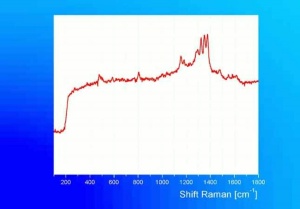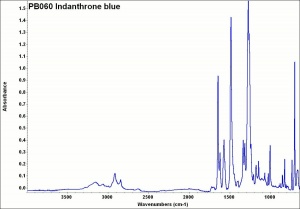Difference between revisions of "Indanthrone blue"
(username removed) |
(username removed) |
||
| Line 1: | Line 1: | ||
== Description == | == Description == | ||
| − | A synthetic blue [http://cameo.mfa.org/materials/fullrecord.asp?name=anthraquinone | + | A synthetic blue [http://cameo.mfa.org/materials/fullrecord.asp?name=anthraquinone%20dye anthraquinone dye]. Indanthrone blue was first prepared as an [http://cameo.mfa.org/materials/fullrecord.asp?name=anthraquinone anthraquinone] derivative of indigo by Rene Bohn in 1901. He named the colorant indanthrene, but the name was changed to indanthrone when Indanthrene® became a brand name [I.G.Farbenindustrie A.G.] for the colorant. Indanthrone is rarely used as a colorant because it is similar in hue to [http://cameo.mfa.org/materials/fullrecord.asp?name=phthalocyanine%20blue phthalocyanine blue] but is more expensive. |
== Synonyms and Related Terms == | == Synonyms and Related Terms == | ||
| − | + | Indanthrene® blue [I.G.Farbenindustrie A.G.]; Pigment Blue 60; CI 69800; Vat Blue 4; indanthrene blue R; indanthrene brilliant blue FF; anthraquinone blue; faience blue | |
[[[SliderGallery rightalign|indanthroneblue632.jpg~Raman|PB060 Indanthrone blue.jpg~FTIR]]] | [[[SliderGallery rightalign|indanthroneblue632.jpg~Raman|PB060 Indanthrone blue.jpg~FTIR]]] | ||
| Line 34: | Line 34: | ||
== Authority == | == Authority == | ||
| − | * | + | * M. Doerner, ''The Materials of the Artist'', Harcourt, Brace & Co., 1934 |
| − | * | + | * Website address 1 Comment: www.straw.com/sig/dyehist |
* Website address 2 Comment: http://www.coloria.net/variti.htm - gives as C34H16O2 for PB65, vat blue 20, CI 59800 and as C28H14N2O4Cl3 for PB21, CI 69835 | * Website address 2 Comment: http://www.coloria.net/variti.htm - gives as C34H16O2 for PB65, vat blue 20, CI 59800 and as C28H14N2O4Cl3 for PB21, CI 69835 | ||
| − | * | + | * A.Scharff, 'Synthetic dyestuffs for textiles and their fastness to washing', ''ICOM-CC Preprints'' Lyon, Getty Conservation Institute, Los Angeles, 1999 |
| − | * | + | * Monona Rossol, ''The Artist's Complete Health and Safety Guide'', Allworth Press, New York, 1994 |
* Art and Architecture Thesaurus Online, http://www.getty.edu/research/tools/vocabulary/aat/, J. Paul Getty Trust, Los Angeles, 2000 | * Art and Architecture Thesaurus Online, http://www.getty.edu/research/tools/vocabulary/aat/, J. Paul Getty Trust, Los Angeles, 2000 | ||
Revision as of 06:30, 24 July 2013
Description
A synthetic blue anthraquinone dye. Indanthrone blue was first prepared as an anthraquinone derivative of indigo by Rene Bohn in 1901. He named the colorant indanthrene, but the name was changed to indanthrone when Indanthrene® became a brand name [I.G.Farbenindustrie A.G.] for the colorant. Indanthrone is rarely used as a colorant because it is similar in hue to phthalocyanine blue but is more expensive.
Synonyms and Related Terms
Indanthrene® blue [I.G.Farbenindustrie A.G.]; Pigment Blue 60; CI 69800; Vat Blue 4; indanthrene blue R; indanthrene brilliant blue FF; anthraquinone blue; faience blue
Other Properties
Turns orange then dissolves in concentrated sulfuric acid. Insoluble in organic solvents.
UV max = 278 nm
| Composition | C28H14N2O4 |
|---|---|
| Molecular Weight | mol. wt. = 442.43 |
Hazards and Safety
Closely related to cancer causing anthraquinones.
Additional Information
M.de Keijzer, "Microchemical Analysis on Synthetic Organic Artists Pigments Discovered in the Twentieth Century" in ICOM Preprints, Dresden 1990, p. 221-225.
Authority
- M. Doerner, The Materials of the Artist, Harcourt, Brace & Co., 1934
- Website address 1 Comment: www.straw.com/sig/dyehist
- Website address 2 Comment: http://www.coloria.net/variti.htm - gives as C34H16O2 for PB65, vat blue 20, CI 59800 and as C28H14N2O4Cl3 for PB21, CI 69835
- A.Scharff, 'Synthetic dyestuffs for textiles and their fastness to washing', ICOM-CC Preprints Lyon, Getty Conservation Institute, Los Angeles, 1999
- Monona Rossol, The Artist's Complete Health and Safety Guide, Allworth Press, New York, 1994
- Art and Architecture Thesaurus Online, http://www.getty.edu/research/tools/vocabulary/aat/, J. Paul Getty Trust, Los Angeles, 2000

